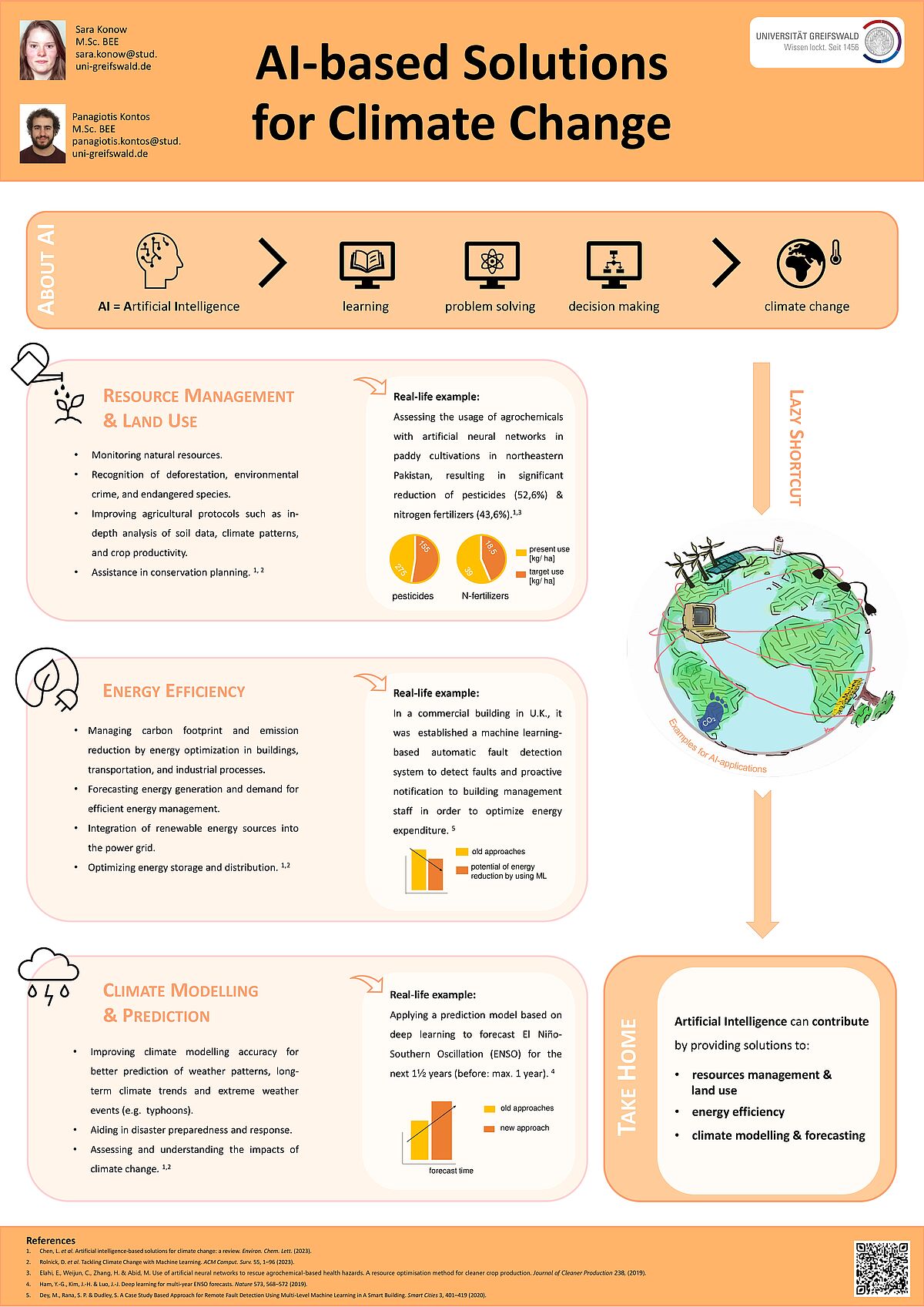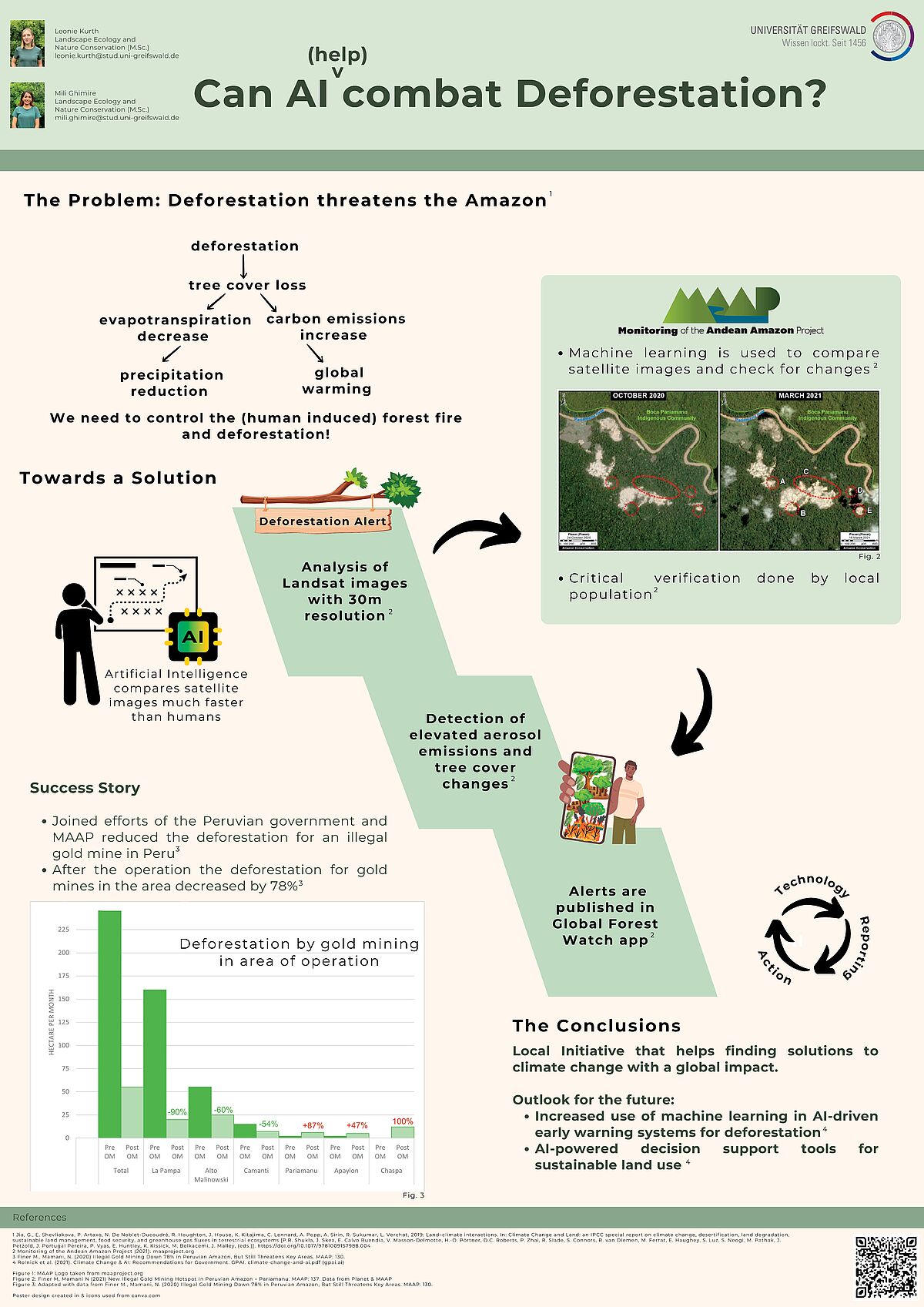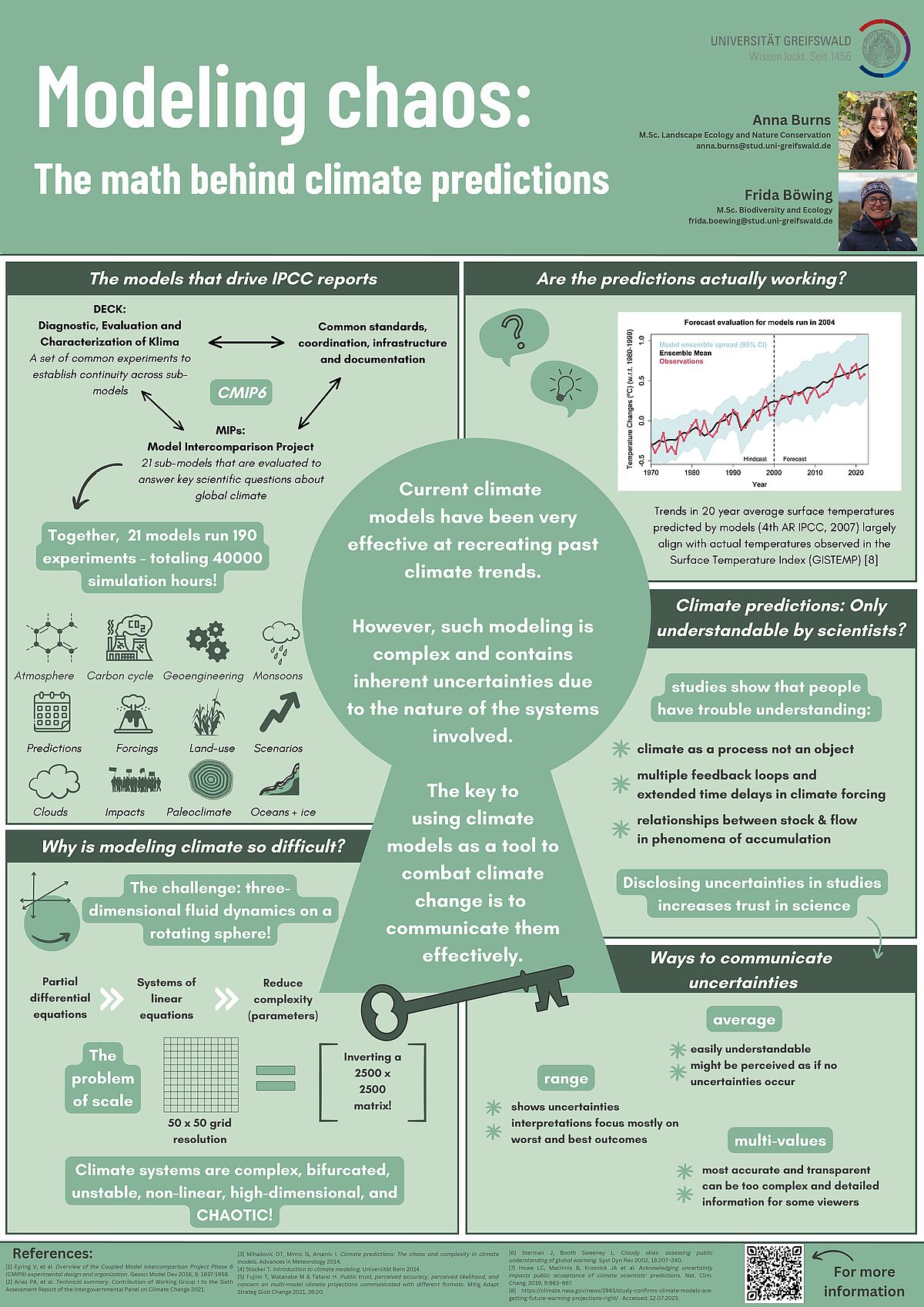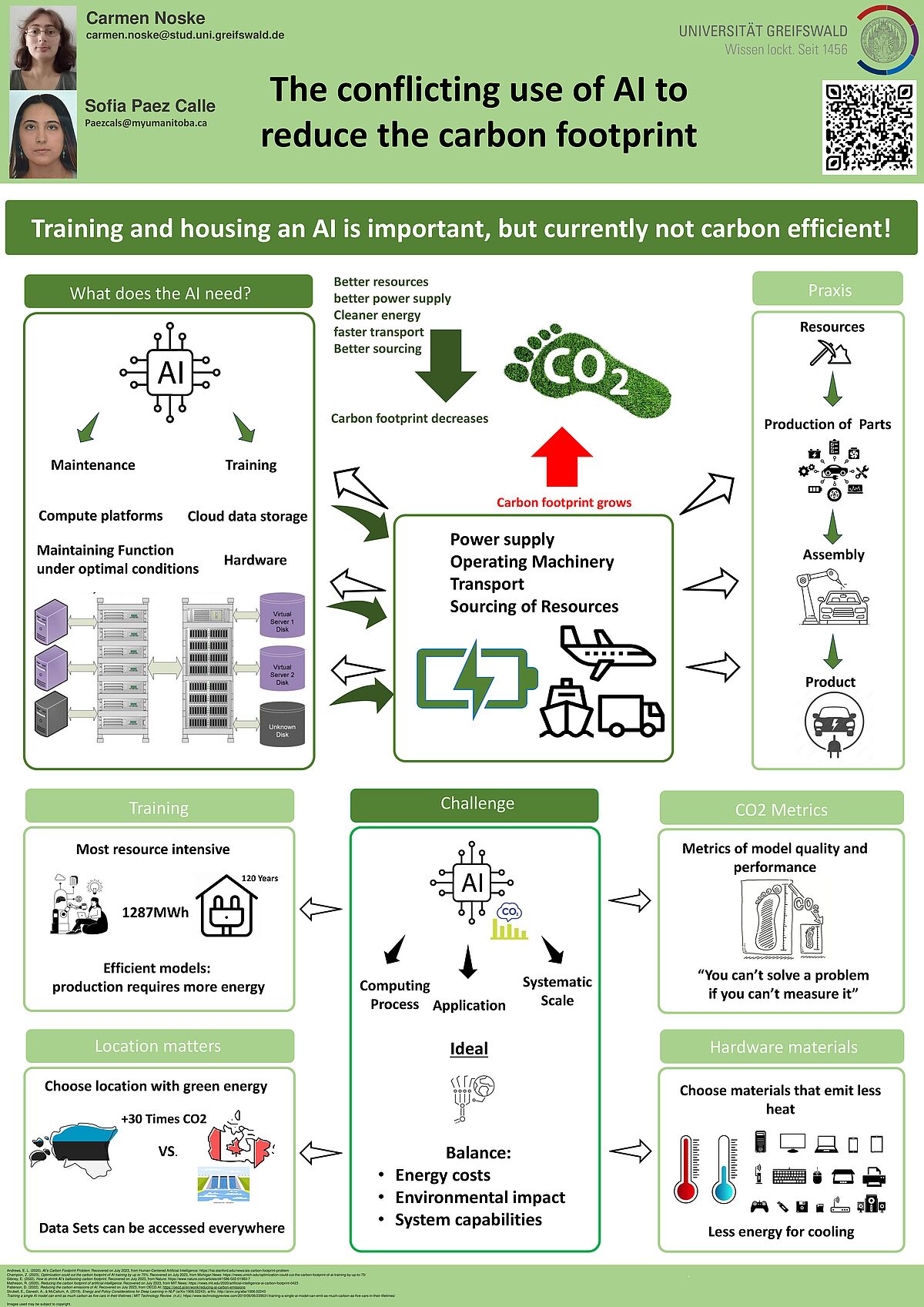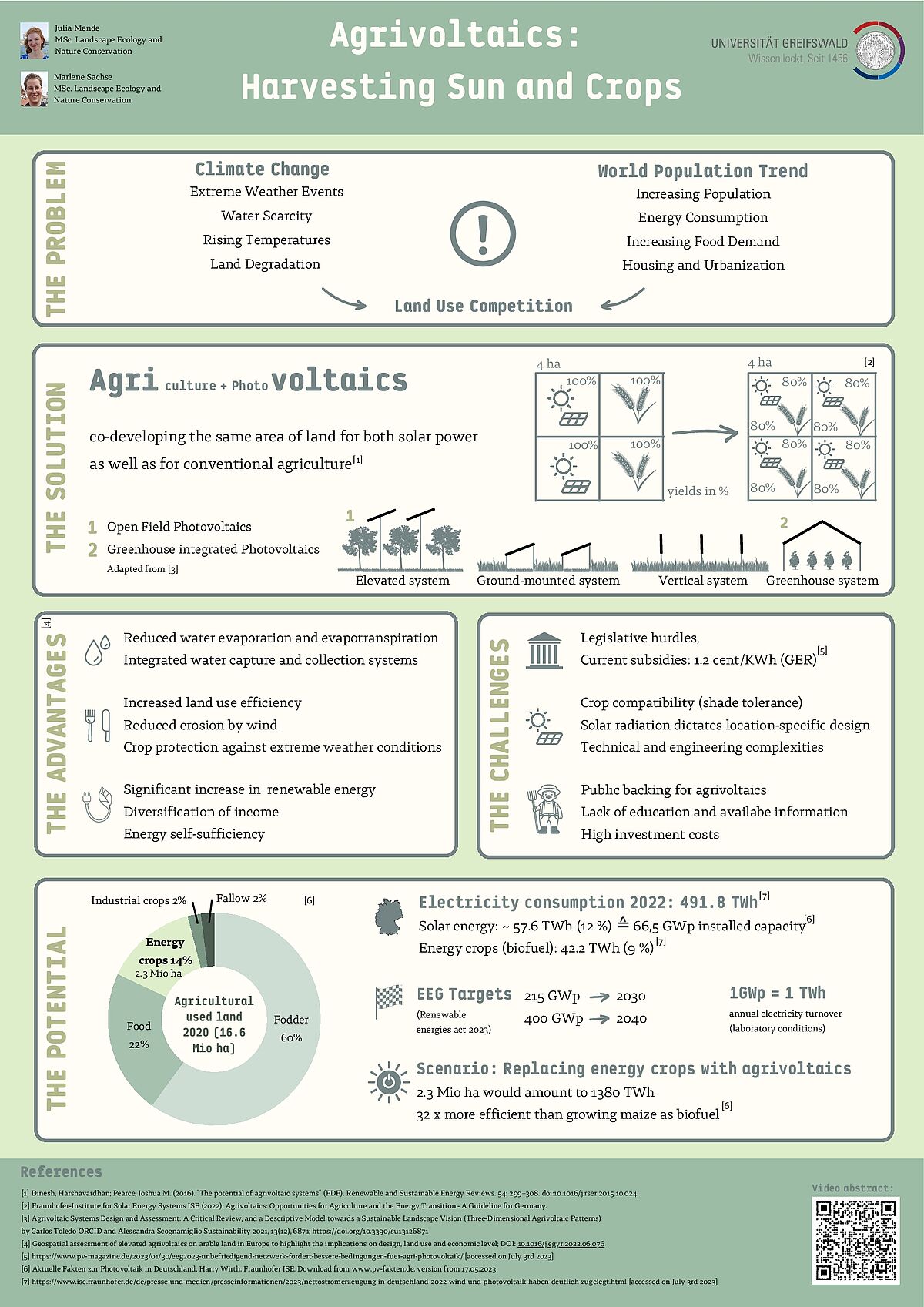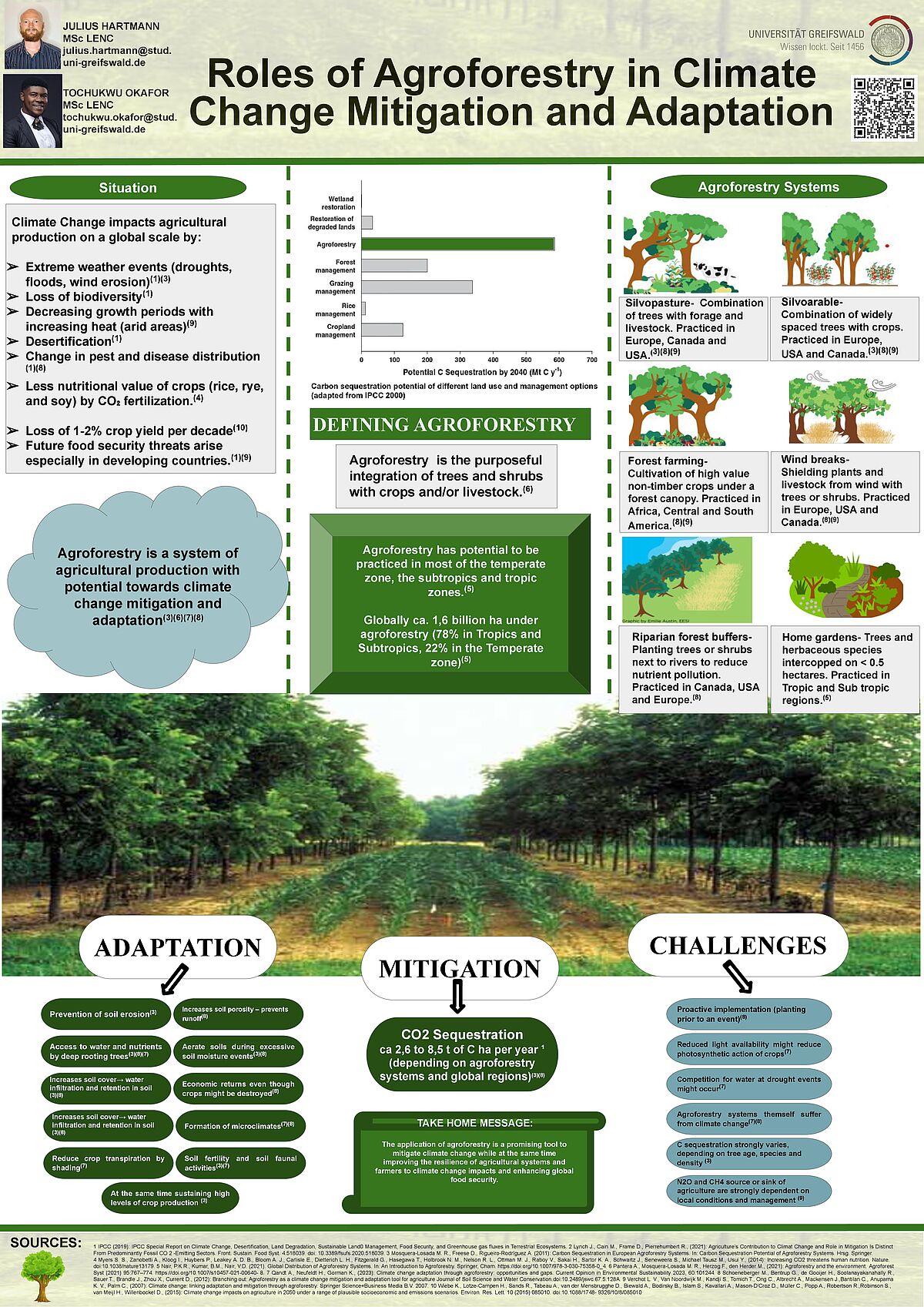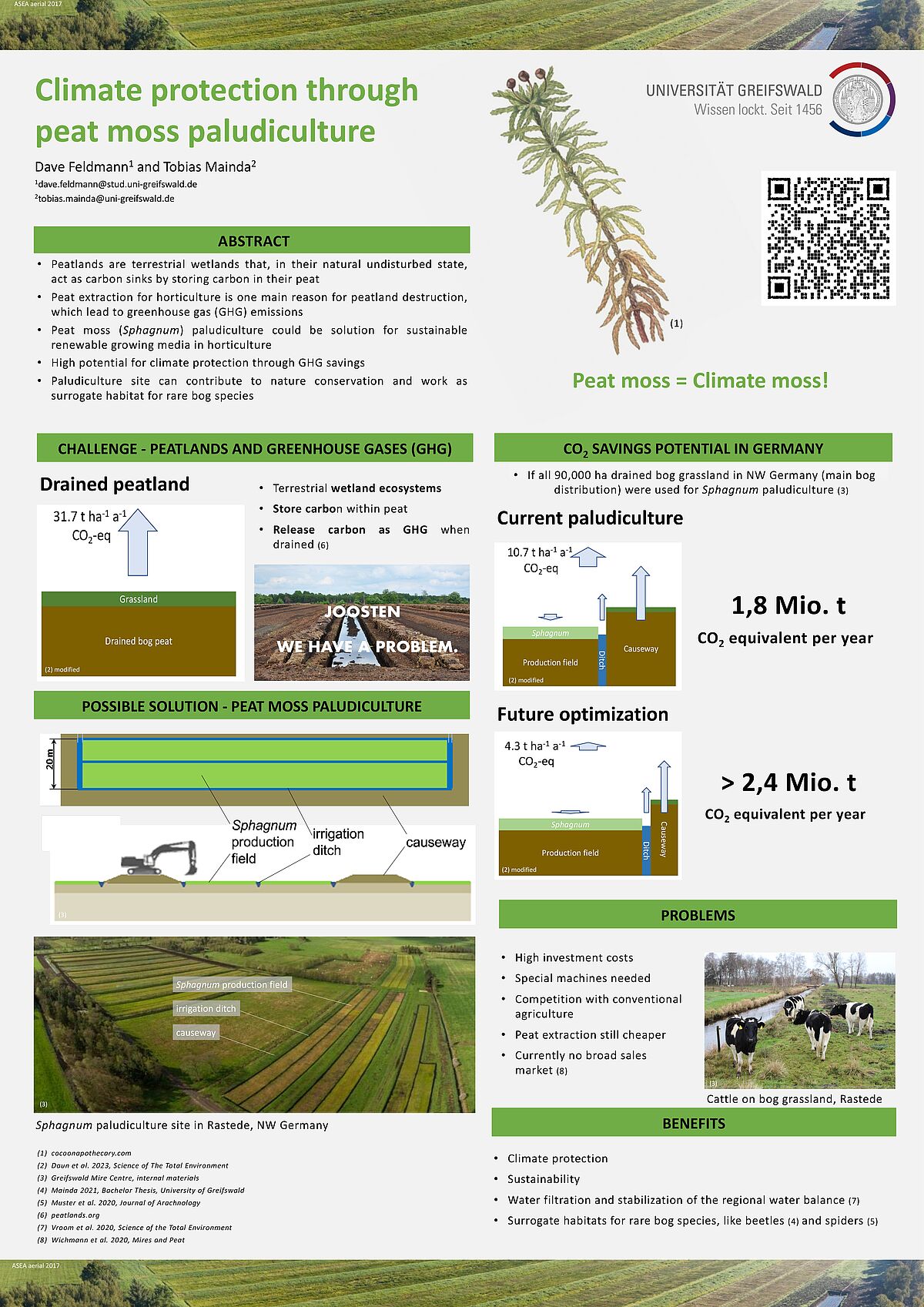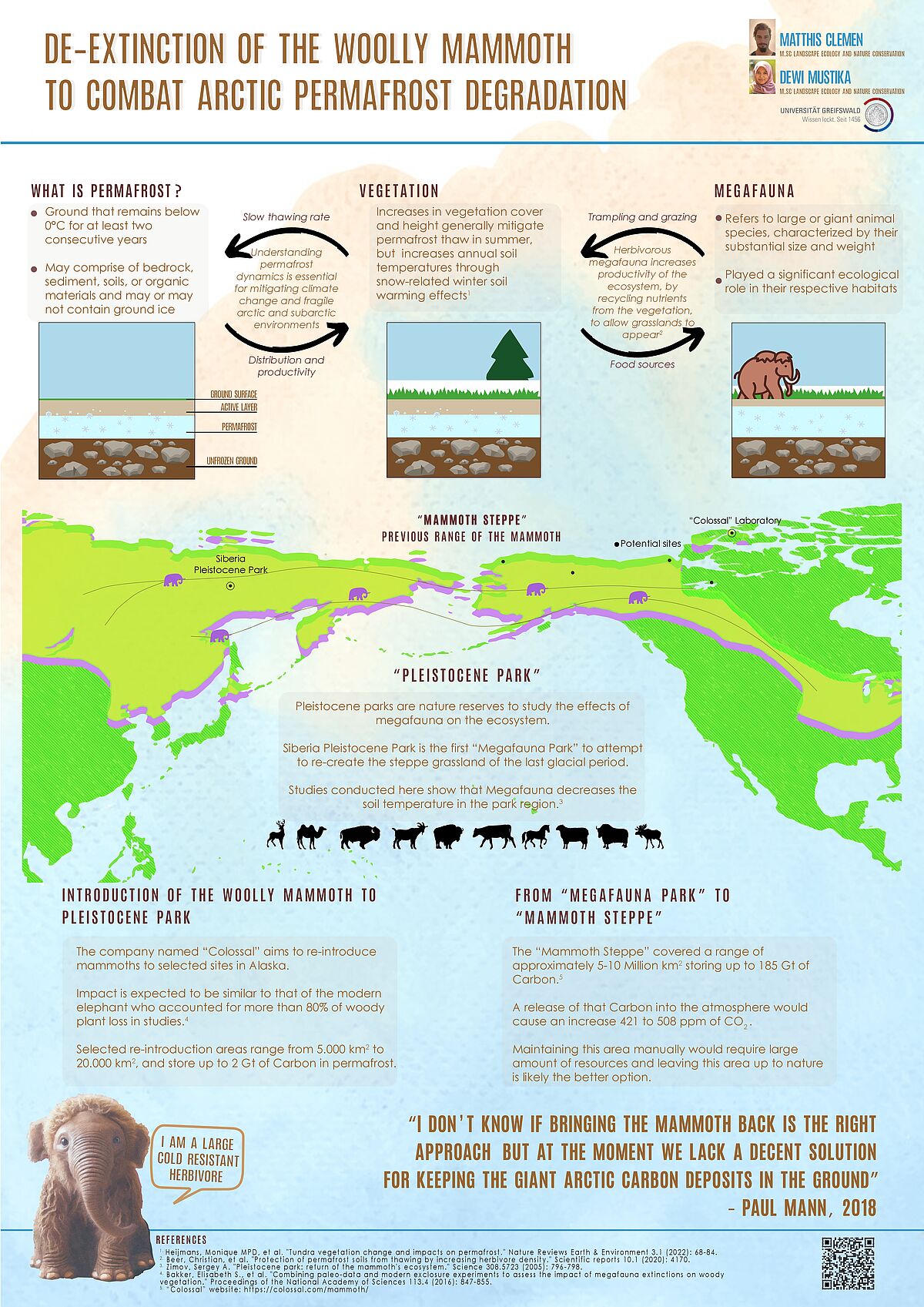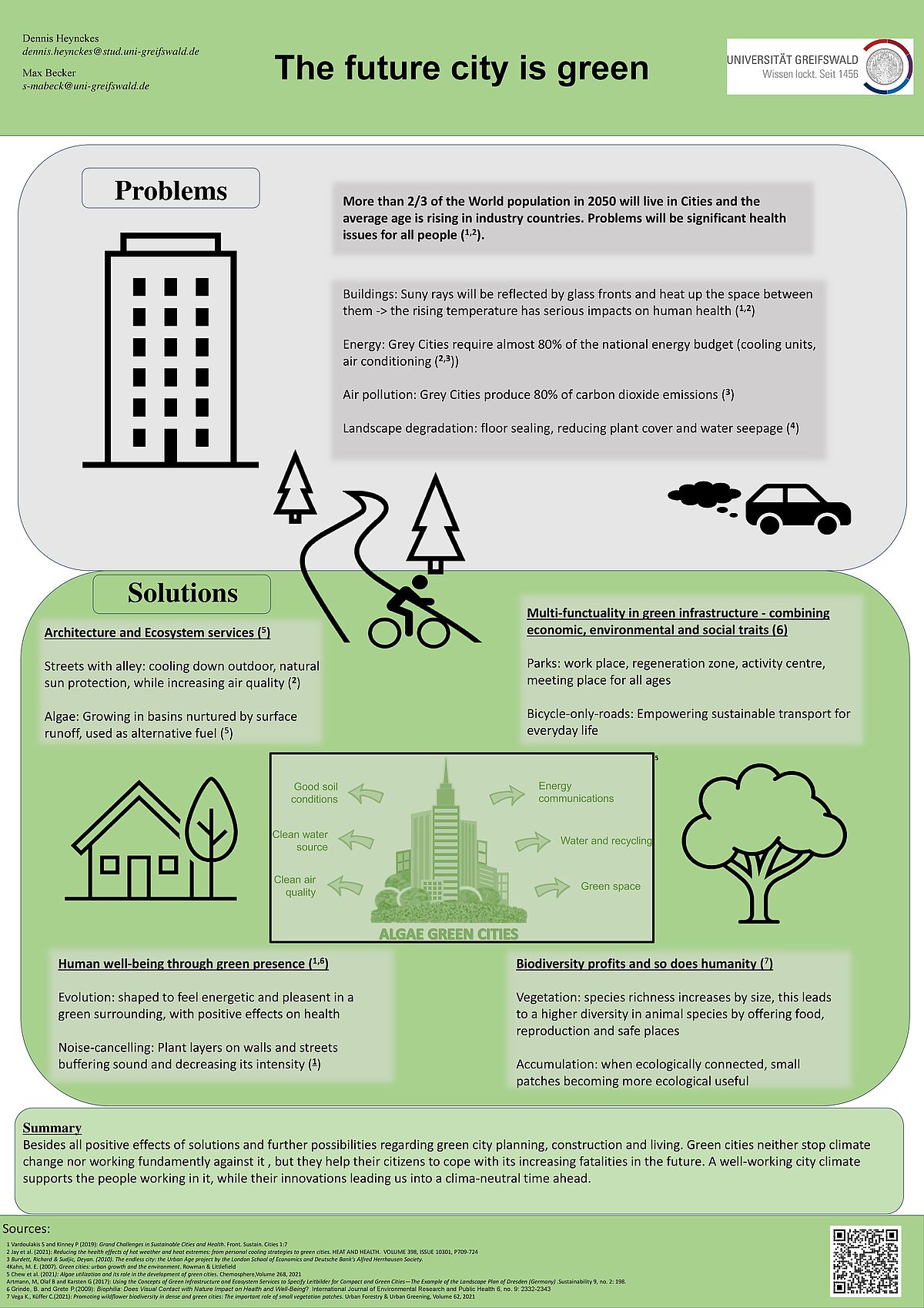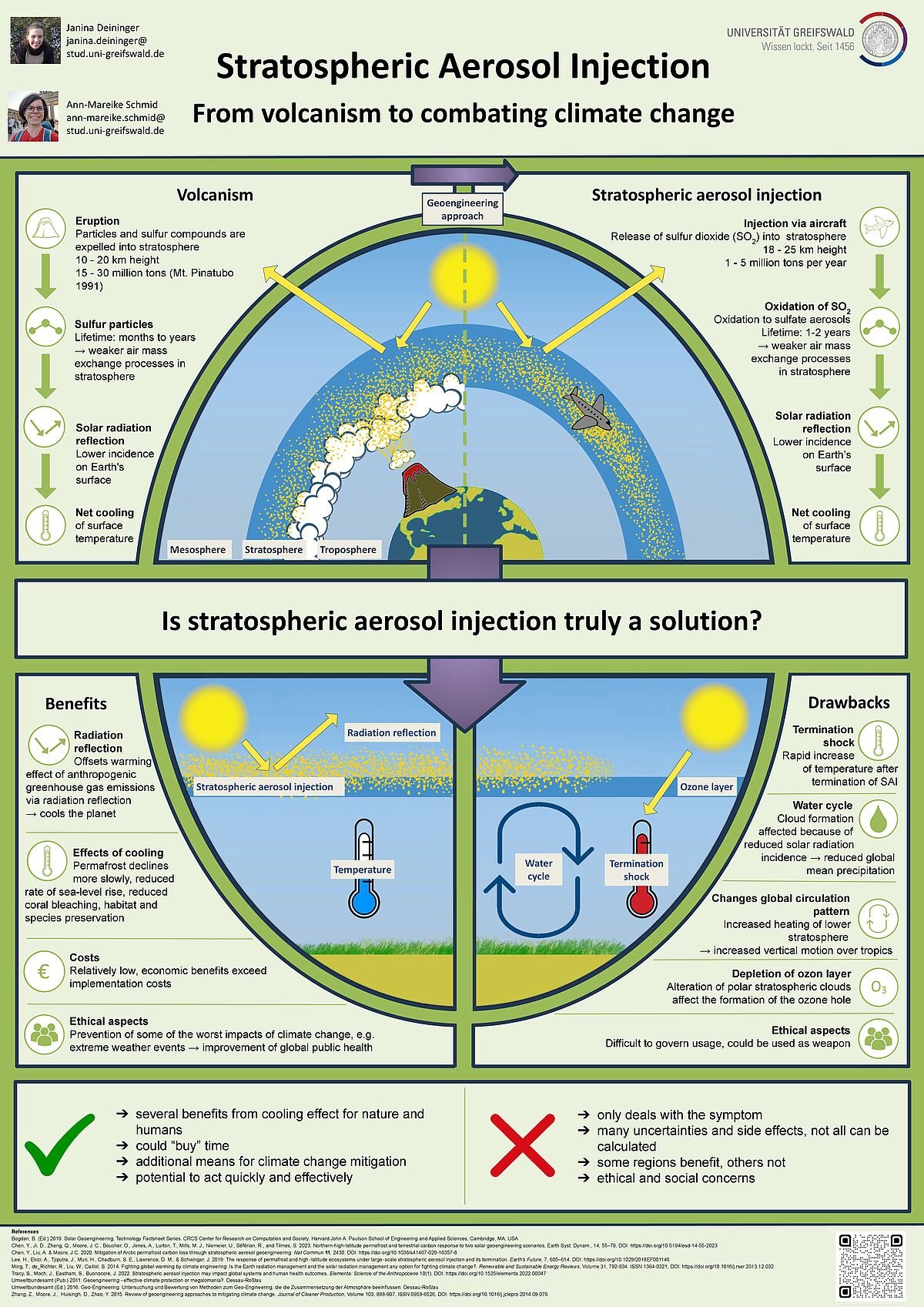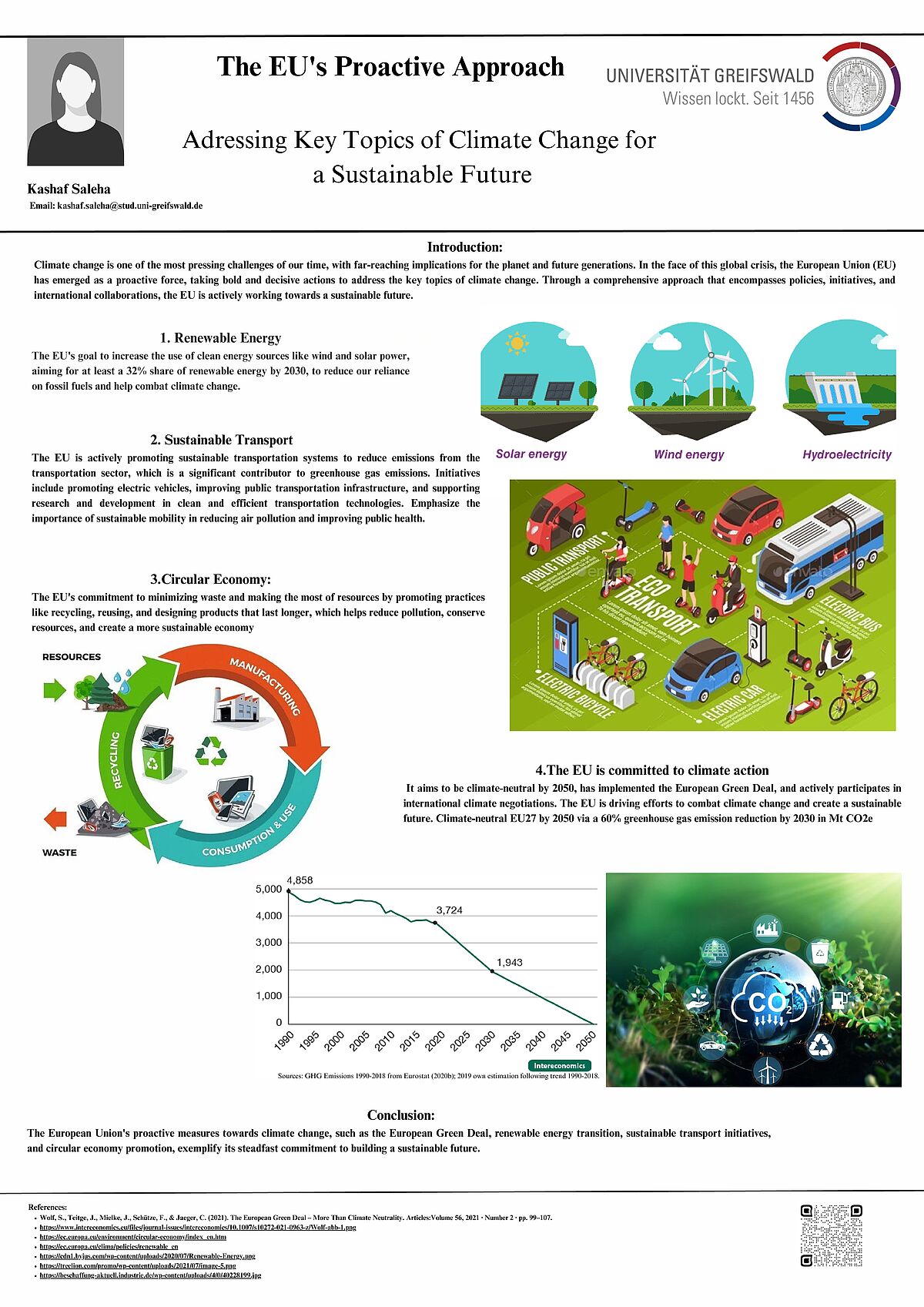
Below you can find all the contributions from students in the summer semester 2023 in the "Climate Change" module from Prof. Martin Wilmking, Ph.D.
For every topic you can find a short overview, the student's poster contribution and a 3 minutes video abstract.
Enjoy the virtual tour.
SESSION 1
AI and Modelling
1) AI-based Solutions for Climate Change
Since the popularity of ChatGPT, Artificial Intelligence (AI) has been the talk of the town. AI has already proven to be a powerful tool, and this also applies to one of the most important problems of our time: climate change. AI-based solutions offer promising opportunities, such as data-driven insights on optimization and enabling efficient decision-making. AI methods, such as Machine and Deep Learning, not only help with energy efficiency and natural resource management but also enhance climate modelling and predictions. If this interests you, check out our additional material for an overview of AI-based solutions in climate change.
2) Can AI (help) combat deforestation?
Deforestation is a driver contributing to the current anthropogenic climate change. The decrease in tree cover often combined with forest fires leads to increased emissions and therefore global warming. It is without doubt that we have to slow down and eventually stop deforestation. Analysis of satellite imagery with Artificial Intelligence can assist in making the search for changes a lot easier and faster. Tree cover changes can be spotted from above and then create a deforestation alert in the Global Forest Watch app. Then, the AI cannot work alone anymore, but needs human help to confirm the alerts.
3) Modelling chaos: the math behind climate predictions
Climate models are one of the most powerful tools available to understand how the Earth's climate is changing. They provide key evidence in climate policies from the IPCC and the United Nations. However, the mathematics behind the models are complex, and the mechanisms driving the models' conclusions are confusing for scientists and the public alike. In order to use climate models to their full potential, it is necessary to communicate the their findings in a way that builds public and scientific trust in the modeled conclusions and empowers informed policies to combat climate change.
4) The conflicting use of AI to reduce the carbon footprint
Nowadays, we look to Artificial Intelligence to solve many problems. One of these applications is the reduction of the carbon footprint, were AI especially in the industry are used to reduce the footprint of products or whole companies.
But since AI are still dependant on a power source and there are few locations, that rely on green energy, the training alone of one AI has the same carbon footprint as five cars together in their lifetime.
Still there is hope with the advance of green energy and further research into better hardware for the AI.
SESSION 2
Nature-Based Solutions
5) Agrovoltaics: Harvesting sun and crops
The changing climate and growing world population result in a competition for land use for food and energy production. Agrivoltaics, the simultaneous use of land for both agriculture and photovoltaics, presents a potential solution. These systems offer benefits such as crop protection, water conservation, and renewable energy generation within the water-food-energy nexus. However, implementing agrivoltaics faces challenges, particularly in Germany. Nevertheless, agrivoltaics have significant potential in the energy transition as vast agricultural areas could be transformed, potentially generating solar energy exceeding Germany's consumption.
6) Carbon capture and storage (CCS) - A climate change mitigation strategy
The IPCC 2022 stated that “Carbon Dioxide Removal (CDR) is necessary to achieve net zero CO2”. Why do we need that exactly? To avoid reaching critical tipping-points in our climate system. We must stay <2 °C global warming until 2100; and CO2 is one of the main greenhouse gases that drive global warming. If you now wonder, how is it possible to remove CO2 from the air, other than via plant photosynthesis, and what to do with it after? Be invited to have a closer look at our poster explaining Carbon Capture and Storage as a Climate Change Mitigation Strategy.
7) Climate change mitigation on peatlands with waterbuffalos
Peatlands drained for agriculture emit greenhouse gases and fuel climate change. In Mecklenburg-Western Pomerania, more than a third stem from organic soils, which in turn implies a large mitigation potential. Water buffalos are an option to cultivate peatlands in a wet way as the undemanding animals love standing water to wallow in it. In Germany, grazing with water buffalo is primarily established in landscape conservation as it has positive impact on biodiversity as well. Although there are challenges, farmers converting their business can benefit from a wealth of experience and get EU subsidies for this wet management of peatlands.
8) Agroforestry: Possibilities for climate change mitigation and adaptation in agriculture
Our Scientific poster highlights the roles of agroforestry in climate change mitigation and adaptation. Agroforestry is the purposeful integration of trees and shrubs with crops and/or livestock. Climate Change impacts agricultural production on a global scale. Some of the impacts are extreme weather events such as droughts, floods and wind erosion, loss of biodiversity, future food security threats, etc. Some roles of agroforestry in climate change mitigation and adaptation includes Carbon sequestration, prevention of soil erosion, access to water and nutrients by deep rooting, formation of micro climates, among others.
9) Sphagnum paludiculture and its potential for climate protection
When we think of peatlands, we see primeval nature. With moose and cranes at dawn. That's how peatlands are depicted in nature documentaries. In fact, we often only find cows or excavators in peatlands. Peatlands are in danger. Worldwide. Their protection must be a central component of national and international climate protection. One of the reasons for peatland destruction is peat extraction for horticulture. The cultivation of peat moss (Sphagnum paludiculture) can be the solution here. A combination of climate, nature and species protection. Sphagnum has the same properties as the peat it forms and offers a sustainable substrate solution.
10) The De-Extinction of the Woolly Mammoth to combat Arctic Permafrost degradation
The De-Extinction of the Woolly Mammoth is a project executed by the company “Colossal Laboratories & Biosciences”, aimed to assist in the preservation of Arctic permafrost. The Woolly Mammoth as an enormous herbivorous animal has been a key species to keep the “Mammoth Steppe” intact until their extinction approximately 4000 Years ago. They kept shrubs and trees under control allowing a continuous snow-cover to increase albedo of the environment and flattened it to decrease its insulation properties. This decreased annual soil temperatures allowing for permafrost to persist for thousands of years and keep gigantic carbon storage in the ground.
SESSION 3
Technical and Political Solutions
11) The future city is green
Climate change is controversial and progressing steadily. The emission of additional pollutants within cities further worsens the situation. Likewise, the constant warming caused by cities is increasing. All in all, the quality of people's lives is reduced. Green cities should contribute to a more natural feeling and better living conditions. Urban greening, multifunctional use of parks, sustainable transport possibilities and water recycling are the instruments for a flourishing future. Turning a city into a green city is a start in the fight against the consequences of climate change.
12) Climate Change & Architecture: Mitigation and Adaptation Strategies
Buildings and the built environment are responsible for 40% of total energy consumption and CO2 emission worldwide, which is one of the major contributors to global Climate Change. Incorporating cutting edge technology in the building sector might pave the way towards sustainable infrastructure development, which can be a viable mitigation and adaptation strategy. Sustainable architectural practice, which include integrated building design and unique structural adaptation strategies, can reduce energy consumption and CO2 emission from the built environment by 50-75%.
13) Stratospheric aerosol injection - From volcanism to combating climate change
As temperatures on planet Earth continue to rise, finding solutions to reduce global warming becomes of increasing importance. One technical approach to combat climate change is solar geoengineering. This poster more specifically investigates stratospheric aerosol injection (SAI) answering how humans have learned from the climatic effect of volcanic eruptions, and how this knowledge can be translated into a technical solution for cooling down the planet. Furthermore, it highlights the benefits and drawbacks to this approach, posing the question: Is stratospheric aerosol injection truly a solution?
14) The European Union's Proactive Approach: Addressing Key Topics of Climate Change for a Sustainable Future
This poster highlights the European Union's proactive approach in addressing climate change for a sustainable future. By initiatives for example the European Green Deal, transition of clean energy, greener transportation, and circular economy model, the EU reveals its commitment to fighting climate change and raising environmental sustainability. By showcasing these key topics, the poster underlines the EU's efforts to reduce greenhouse gas emissions, encourage clean energy sources, generate sustainable transport systems, and foster resource efficiency. By its proactive stance, the EU gives a strong model for global climate action, contributing to the collective efforts in making a sustainable and strong world.

